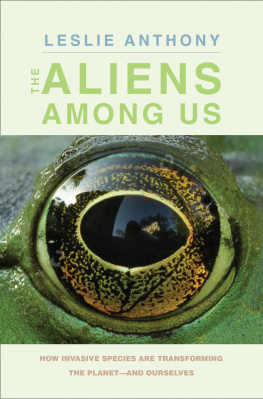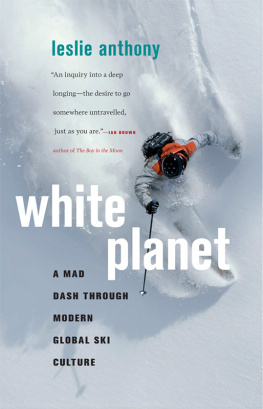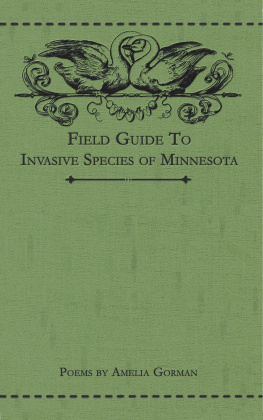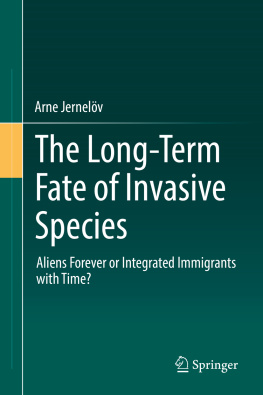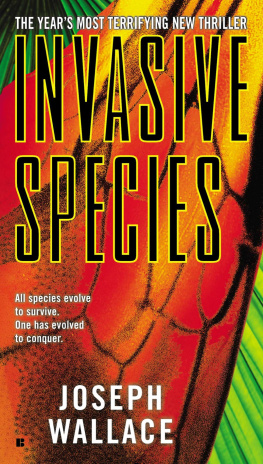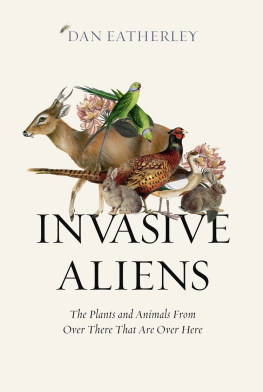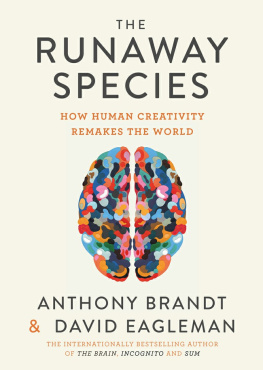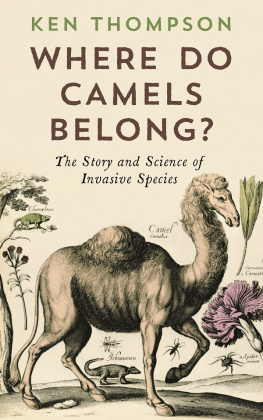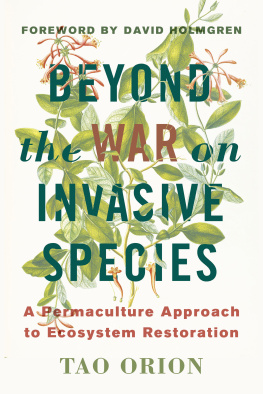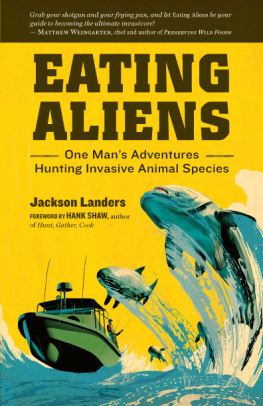The Aliens Among Us

Copyright 2017 by Leslie Anthony.
All rights reserved.
This book may not be reproduced, in whole or in part, including illustrations, in any form (beyond that copying permitted by Sections 107 and 108 of the U.S. Copyright Law and except by reviewers for the public press), without written permission from the publishers.
Yale University Press books may be purchased in quantity for educational, business, or promotional use. For information, please e-mail (U.K. office).
Set in Minion type by IDS Infotech, Ltd.
Printed in the United States of America.
Library of Congress Control Number: 2017937194
ISBN 978-0-300-20890-0 (hardcover : alk. paper)
A catalogue record for this book is available from the British Library.
This paper meets the requirements of ANSI/NISO Z39.48-1992 (Permanence of Paper).
10 9 8 7 6 5 4 3 2 1
for Petal
a lover of plants
a respecter of nature
a plucker of heartstrings
Instead of six continental realms of life, with all their minor components of mountain tops, islands and fresh waters, separated by barriers to dispersal, there will be only one world, with the remaining wild species dispersed up to the limits set by their genetic characteristics, not to the narrower limits set by mechanical barriers as well.
Charles Elton, The Ecology of Invasions by Animals and Plants
Contents
Acknowledgments
T he issue of invasive species is both enormous and important. These organisms not only have been physically dislocated to new lands from the ecosystems in which they evolved, but also, as this book avers, have infiltrated both the public psyche and most institutions in their adopted homes. Thats a lot to wrap your head around, meaning a project of this magnitude would never have found its way unless a critical path forward had presented itself. It was, fortunately, a human compass that offered that direction: my friend and colleague Nicholas Mandrak at the University of Toronto. Our first chat on the subject neither hinted at the Pandoras box he was opening nor revealed what his eventual commitment to shutting it would be. In the end, many hours of what likely would have been more valuable time to him was spent graciously sharing with me his hard-won knowledge on fisheries science, aquatic biodiversity, and the ecosystems of the Great Lakes. I believe I owe him an infinite amount of beer, a debt that I live in fear he will try to collect on.
At least I can blame Mandrak for the fact that Becky Cudmore, commander of the Asian Carp Program at Canadas Department of Fisheries and Oceans (DFO), suffered similarly pesky visits. Numerous phone and office consultations with another friend, Isaac Bogoch, opened a window on geographical epidemiology and invasive vector-pathogen pairs in emerging global diseases.
Beyond the considerable contributions of these three, Ill first salute those who figured most in piquing my interest on invasives: Charles Elton, author of The Ecology of Invasions by Animals and Plants; David Quammen, for his Planet of Weeds essay in Harpers, and the tireless (youll understand this later) ecologist Daniel Simberloff for his voluminous work, much of which Ive now had the pleasure to read. Informally, through Simberloff collaborations, and formally through Man-drak, I was introduced to the equally tireless Anthony Ricciardi, who provided more grist in a single phone call than any other made over the four years of this project. Editors James Little at explore, Clare Ogilve at PIQUE Newsmagazine, Dan Rubinstein at Canadian Geographic, Cooper Langford at Canadian Wildlife, and Robyn Smith at Tyee.ca enthusiastically published articles from which parts of this book are drawn.
My first invasive-related assignment for explore took me to Florida, where I hefted five-meter Burmese pythons but came away more impressed with the heft of those working to thwart their effects: Meg Lowman and Skip Snow were enormously helpful and facilitative, and George Cera and Karen Garrod both let me tag along in the field.
Next stop was Haida Gwaii, where Laurie Wein and the Parks Canada rat patrol of Peter Dyment, Debby Gardiner, Tysen Husband, and Clint Johnson Kendrick welcomed me into their bobbing North Pacific sanctum. I cant thank Parks terrestrial ecologist Carita Bergman enough for the time she took to discuss ecological restoration in Haida Gwaii. Also helpful were British Columbia Conservation Officer James Hilgemann, Parks PR specialist Heather Ramsey, Barb Wilson of the Haida Nation, and Ainsley Brow, Lexi Forbes, and Roger Packham of Coastal Conservation. On the other side of the country, Marie-Jose Lgar of Quebec National Parks (Spaq) accompanied me on a magical trip to Lle dAnticosti, even tracking down mayor-cum-deer-biologist Denis Duteau for a thought-provoking dinner.
Clare Greenberg of the Sea to Sky Invasive Species Council and her team of Sam Cousins, Rob Hughes, Breanne Johnson, and Sharon Watson no doubt found me as tenacious as a knotweedand at times harder to get rid ofyet Greenberg was never too busy to share her thoughts and expertise. Thanks also to SSISC alumnus Kristina Swerhun and, especially, SSISC and Whistler Naturalists founder Bob Brett, whose personal invasive-plant crusades are legend. Richard Beard offered insight into ecological restoration and commercial invasive plant removal when I joined his Green Admiral crew of Julia Alards-Tomalin and Wade McCleod for a day. Trevor Cox connected me with Fiona Steele at Diamond Head Consulting, who not only took time to meet, but arranged for me to accompany crews led by Jeff Hunter and Keith MacKenzie. Others who took time to converse about invasive plants include Ken Crosby at City of Surrey, Sharon Gillies at University of the Fraser Valley, and Melinda Yong at City of Burnaby.
I owe a huge debt of gratitude to my overworked but ever-helpful friend, Purnima Govindarajulu, at British Columbias Ministry of the Environment. More aid with B.C.s invasive bullfrogs came from Sara Ashpole, Christian Engelstoft, Natasha Lukey, and Stan Orchard. Rylee Murray deserves special thanks for a lively nighttime tour of the Fraser Valleys croaking masses.
Phone chats with Lee Frelich delivered the equivalent of a university course on invasive earthworms in Minnesota, and Erin Cameron happily extended the subject to Alberta and Finland. Ant-whisperer Sean McCann opened my eyes to the scourge of Myrmica rubra, and Chris Higgins of Thompson Rivers University in Kamloops filled me in on what that means to the nave ecosystems of North America. I enjoyed a lengthy discussion on Americas imported red fire ants with University of Pennsylvania doctoral student Chris Thawley. Troy Kimoto of the Canadian Food Inspection Agency schooled me on invasive insects, and University of Torontos Sandy Smith and Robert Bourchier of Agriculture Canada further educated me on the history and current status of biocontrol in North America.
David Galbraith introduced me to lands manager Tys Theysmeyer at the Royal Botanical Gardens in Hamilton, Ontario, who ground-truthed with me the impacts of invasive common carp, Phragmites, irruptive cormorants, and Canada geese. Johanna Liemivuo-Lahti of the Government of Finland shared tea, biscuits, and her magnum opus on the prevention, control, and monitoring of invasive species. Sean Fox opened the gates to the Guelph Arboretum and the secrets of American elm and American chestnut restoration. A chat with Helen Kennedy of Arlos Honey Farm in Kelowna about bees and Varroa mites led to a fruitful discussion about invasive starlings with Jane Hatch of Tantalus Winery. Oceanwide Expeditions spokesperson Rima Deeb Granado answered emails about landings on sub-Antarctic islands, and biologist David Marson answered questions about the Asian carp lab run by DFO. Jacqueline Litzgus invited me to the mind-bending Thinking Extinction conference at Sudburys Laurentian University, where Arne Moores of Simon Fraser University provided perspectives on evolutionary rates, biodiversity, and the unique vulnerability of monotypic organisms. Axel Moehrenschlager of the Calgary Zoo and University of Calgary invited me to a workshop on the vanishing sage grouse, my introduction to the world of captive breeding, reintroduction, and translocation.
Next page
